There are two words that are so closely linked, they are almost synonymous: love and truth. You can’t have one without the other. Ever. So while the whole world may boil down to one basic thing—love—the way to get there is through the doorway of truth. If we know the whole truth about anything, we will feel love, and if our hearts are all the way open, we will know the truth. We will be living in the Oneness.
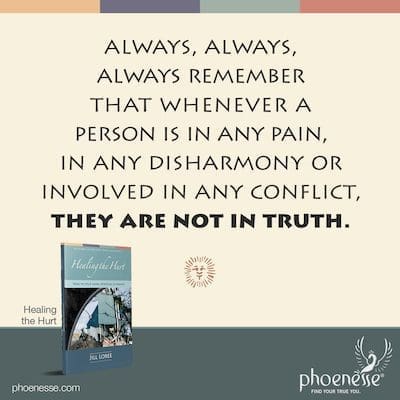
The key is to always, always, always remember that whenever a person is in any pain, in any disharmony or involved in any conflict, they are not in truth. But stuck as they are in the painful life situation the Worker is experiencing, they are not able to see the truth. This is where working with a Helper comes in. Our job as the Helper is to listen for the distortions so we can help lead the Worker to the truth.

We’re Listening from the Get-Go
So the Worker comes in, sits down a comfortable distance from us with chairs directly facing each other, and we attune. (Read more in A Word about Attuning.) We will want to open up our minds during the attunement and hear what comes out of our mouths. Let spirit speak. Then see how the words become a thread that gets woven into the session.
At this point, we have also already been listening to the Worker. Things the Worker says in those unguarded and sometimes awkward moments at the beginning of a session are often ripe with clues about what’s on their minds or about what needs to surface in the session. Same for at the end of the session, which may give us ideas to bookmark for exploration in the next session. Some might call it listening-while-their-hand-is-on-the doorknob. Often, the Worker’s comments provide adequate fodder for going right into the session.
Worker: (trying to get comfortable in chair) My back is killing me. It started hurting last night and I hardly slept.
Helper: Let’s invite it to be here with us. Bring your breath into that part of your back. Let’s give it some space and open up to what it’s about.
It’s also possible the Worker has something specific on their mind to explore. A helpful question to lead off with, and supposedly one that Eva Pierrakos favored, is: What do you bring today? If used regularly, this question can become a helpful self-guidance tool for longtime Workers to begin asking themselves when they are tilling the soil prior to their session, or as part of their daily exploration about what needs tending.
One thing to always keep in mind, there are no two (or more) things in a person’s life that don’t somehow fit together as part of a bigger overall puzzle. So it’s helpful to let disparate pieces all come into the session. For example, how does not feeling recognized at work relate to not finding fulfillment in an intimate relationship? What’s the connection? Trust that there is one.
Listening for Dualities & Images
In large part, the job of a Helper is to hold the flashlight. But this can be harder than it looks because we need to figure out which corner to shine the light into. If we’re a Helper, that means we’ve done a lot of our own work, so by now we know that under all our dramas there is a duality playing itself out. What’s harder to discern is the way in which our Helper skillfully managed to help us when we were lost in the dark.
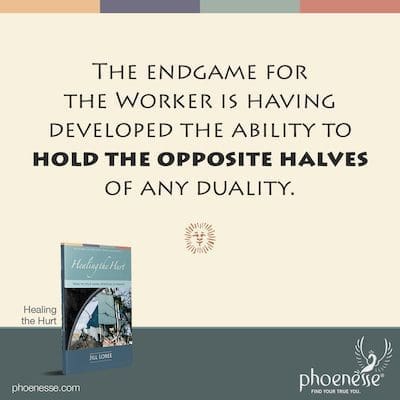
The endgame for the Worker is to sit in unitive consciousness having developed the ability to hold the opposite halves of any duality. And perhaps the most fundamental duality is the experience of pleasure and pain: we want one; we really don’t want the other. Of course, what the Worker discovers over time is that the healing waters of their tears are like a magic key that softens and eventually opens the heart. And what could be more pleasurable than the felt experience of love right there in the heart center? But there are many miles one must travel before reaching that point.
The Worker usually starts out feeling trapped in a “no way out” scenario where there are two opposite and equally unappealing options. At this level of duality, the Worker is caught on the plane of the ego, and they are not in truth. The good news is, all duality is an illusion. The bad news is, the Worker’s still stuck in it.
Worker: I am miserable in this relationship, but I can’t leave.
Helper: Why don’t you want to leave?
Worker: I have left so many other relationships. And if I leave again, I’ll be alone again, and more than anything else, I hate being alone. There is nothing worse than being lonely.
Underneath every duality is a hidden belief, an image, that needs to be explored. The Worker is going to state this wrong conclusion with such matter-of-fact conviction, it will seem like a hardwired fact of life. We need to prick up our ears and listen for it when it comes. In this example, there is a belief that to be alone is to be lonely, which is painful.
Helper: I think I may be hearing an image—the belief that it is always painful to be alone, that being alone means you must be lonely.
Worker: Well, yeah.
Helper: Notice the part of you that feels you can’t tolerate the pain of being alone. Like it will kill you.
Worker: I hate feeling like this.
Helper: Let’s open this up and ask if this is true. Drop in the question deep inside: Is this true that it must be painful to be alone? (or What is the truth of this matter?)
This is singularly the most powerful question we can teach the Worker to ask: Is this true? Again, any time a person is not in harmony—there’s any pain, any sadness, any depression, any anxiety, any shame—the person is not in truth. It’s really that simple. And the truth will always lift us up. But often we become too engulfed in the disharmony to see anything but the distortions that have us trapped.
When we utter the question “What is the truth?”, the iota of being that has asked this question—which is really tantamount to having said a prayer—is no longer caught in the trap. We now have one toe out of the illusion, and although that doesn’t sound like much, it’s really everything. We have to start somewhere and this is it—the escape hatch.
We never have to fear the truth. When we utter this prayer to know the truth, we will always get an answer. Sometimes information may come flooding in rather quickly. Sometimes, we will need to wait a few days to hear an answer. It may come directly through our own inner channel, if we’re open enough, or we may hear the answer coming through someone else’s mouth. It doesn’t matter how it comes—just know that it will come.
If we knock, the door will open. Always.
Right away, the Worker may bump into their dualistic desire to always be right because being wrong feels like death. But when an image surfaces, it will often feel like this is a truth we have somehow always known and believed, but we weren’t quite aware of it. At other times, it can take awhile for the conscious reasoning mind to catch up with the reality that this is the belief that has been hidden but which has been secretly running the whole show.
It’s helpful to coach the Worker to be open to new possibilities. In this vast, unknowable universe we’re a part of, there are always infinite possibilities. And while perhaps the Worker can’t wrap their brains around this in the moment, it may help to open up their field of vision, moving away from the notion that there are only two options, both of which are bad.
Worker: Every time I have been alone, I have been miserable.
Helper: But you’re in a relationship now and you’re also miserable.
Worker: Well, yes.
Helper: Is it possible that it’s not true that being in a relationship is the way to be happy, and not being in a relationship must always make you unhappy? Do you know of anyone for whom this isn’t true?
In the second level of a duality, we move from having two unacceptable choices to seeing how we are really running away from one side of a duality and toward the other. In this case, the Worker is running away from the loneliness of not being in a relationship by staying in a miserable relationship.
We want to slowly and gently pry open the lid of this duality, sort of how you might go all the way around the lid of a paint can. If what the Worker believes is the truth, then it must always be true. One way to wedge a toe into the door of a duality is by considering that at least in one instance, what we “know” to be true is not true.
It is quite possible that this will need some time to work down into the cracks of the Workers awareness, softening up the soil as we go. We’re using mental concepts and thought processes as our tools, but the work of opening is not an intellectual exercise. The whole being must organically relax and open to let in new wisdom that will surface from the Workers real self. It’s not the job of the Helper to feed them the new truths, but to help the opening and revealing process. An excellent place for the Worker to land is solidly in “I don’t know.” There is no mental place that is more open or more true in that moment. It can help to come into this through the backdoor of knowing one thing for sure, which is “I don’t know.” This gives the mind a place to rest; it knows for sure that right now there is something it doesn’t know.
In fact, here’s something really important to take note of. As we are open ourselves and sitting in Helper Consciousness (read more in What is Helper Consciousness?), we may also be receiving a lot of information about what is going on for the Worker. That’s great. This is useful for knowing where to direct the beam of light. But if we try to feed the answers to the Worker before they are ready, it will feel to them like we are shoving a bitter pill down their throat. Odds are, they will spit it back out. Not because it wasn’t right, but because it didn’t arise naturally from within them when they were ready to hear it.
There is very little risk or harm in ever giving a truth to someone too late. But trying to impart something too early, even if we are hearing the truth loudly and clearly inside ourselves, has the potential to do far more harm than good. We want to sit with the truth, or at least the possibility of the truth, holding this healed presence for the Worker, and giving them all the time and space in the world to open to it for themselves.
Of course, we as Helpers aren’t 100% error-proof in our psychic perceptions. Maybe we don’t quite get the whole picture ourselves, but only a part of it. We can offer what we see with humility and language that makes our words more palatable.
Helper: Is it possible that it’s not true that the only way to be happy is by being in a relationship?
Worker: I don’t know. I’ve never been. But I know a lot of people who are in relationships who aren’t happy.
Here’s something else to look for: when our hidden beliefs surface, they probably won’t make a lot of rational sense. This is the reason it is good for the Worker to speak what they are noticing out loud. Otherwise irrational beliefs can keep percolating away unchallenged. It’s important to remember that the first step is to surface the wrong conclusions about life. They sunk into the unconscious for a very good reason: they didn’t hold a lot of water. Once pushed out of awareness, that pesky detail gets overlooked.
So now is the time to let the inconsistencies and contradictions surface, but our goal as a Helper is not to now rub the Worker’s nose in being wrong. No, that is not at all what we want to do. We want to make space for the disparate, confused parts of the inner self to surface, and we want all the parts to feel welcome. The Worker is already prone to feeling shame about who they are, so we want to tread very lightly in allowing hard-to-look-at-aspects to surface and be accepted.
Helper: Notice how tightly held this belief is in you that to be alone would feel like death. To the young child inside, this probably feels like a life-or-death struggle.
Worker: My parents didn’t pay much attention to me. I remember we went to the fair and I got separated from my parents. I am sure it was just for a few minutes, but I was so scared. I was terrified.
Helper: I am hearing you say it’s terrifying to be alone. Is that what you believe?
Worker: Yes, it’s true. I’m terrified of being alone.
Helper: How old are you feeling right now?
Worker: Young. Maybe six or seven.
There is an origin for every image and childlike logic that makes sense on some level. We need to find the belief and the actual words that are associated with the belief. They will be the words of a young child, perhaps around the age of six or seven. Our main image, which informs our strategy for how to be happy in life, is often formed around this age. We are old enough to project into the future, and when something painful happens, we conclude “this is how the world is.” We go on to craft a defense plan for how to survive.
It is really important for the Worker to find the words that truly resonate for them as being “the truth” of their image. We can offer a few phrases for them to try on, but it is not our job to give this to them. In their unconscious mind, this phrase is sitting there pretty as a picture, and the Worker needs to own the words they have been saying to themselves and believing their whole life.
If they come up with an adult-sounding phrase, like “it is more beneficial to be with someone,” the Worker is not yet at the level of the image itself. They need to keep going until they land on it. It will be stated in the words of a child: it hurts to be all by myself. Then it’s best to write it down, for it’s entirely possible to surface an image, only to have it slip back under the waves and keep doing its damage.
We know that all problems are only outer manifestations of inner misunderstandings. So it is always possible to find a way out if we can find the image—the misunderstanding about life. We need to keep digging until we find the mistaken belief, and then bring in the light of truth. We aren’t all the way through to the other side until new seeds of truth have been planted in the Worker’s psyche.
Questions to offer for consideration by the Worker might include: Is it true that if I leave this relationship I’ll be alone forever? Is it true that I must always be unhappy if I am not in a relationship? Is it true that I can give up what I long for temporarily, trusting God has my best interest at heart? Again, landing in “I don’t know” shows a lot of progress, for in truth, the Worker can’t yet know another truth. They have lived their whole lives until now manifesting experiences that have seemed to confirm that their image is what is true.
When doing this work of exploration and discovery and the eventual letting go of painful feeling, wrong ideas and errant self-will, we will run smack into the Worker’s lack of trust in God. The Lower Self is what blocks the light of our Higher Self, and we are working to clear these obstacles. In the meantime, it may feel like light is in short supply. We always want to be calling on the Higher Self to be felt in the session, while continually holding the presence of God in our own awareness as the Helper.
We will also want to work toward untangling images about God. As part of the work of creating a personal connection with God, we will need to explore the person’s God-image in which they place their reactions to their parents onto God. We want to keep inviting the Worker to go within, calling on the source of all courage, wisdom and love that is living inside them. We want to keep leading them to the water from which they can always drink. In this way, God is present in the session and in the process of healing. Sure, if we knock the door will be opened, but we do have to remember to knock.
Listening for Faults
In our grand goal of living from our Higher Self, we have to clear the weeds and nettles of Lower Self that cover it up in many places. And we can’t clear the Lower Self until we get to know it. We have to see how it operates so we can catch it in action; that’s when the work really begins. Because just knowing about our Lower Self doesn’t make it stop. It goes about its merry way making problems in our lives, and now we just watch ourselves doing it. Nonetheless, awareness is always the first step.
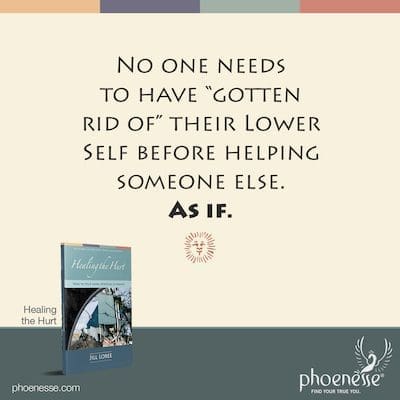
As Helpers, we won’t be much help in identifying the Worker’s Lower Self if we haven’t had a serious sit-down with our own. The Helpership training I went through was both rigorous and extensive, and included the necessary step of meeting my own Lower Self face-to-face as a critical experience before becoming a Pathwork Helper. It’s difficult, if not impossible, to identify in someone else what we haven’t yet had the willingness and courage to see in ourselves.
That said, no one needs to have “gotten rid of” their Lower Self before helping someone else. As if. That’s a nice idea but hardly practical since we all have more work to do, as long as our feet are on this Earth. But we do need to have made some progress in seeing how our Lower Self conducts business. Then having seen it in action, we need to have made some headway in transforming its energy back to the light. In short, we need to have done some work.
So then if we’ve already done some work, we’ve gotten to know our own faults. We can see them coming a mile away and if we are good Workers ourselves, we are regularly taking action to dismantle their fuse, ideally before it sets off too many sparks. But this is a daily ongoing battle. Don’t plan on claiming victory before every little seemingly insignificant war has been won.
This is similar to how it looks in helping our Workers identify their faults. We’re like minesweepers, constantly listening for the blip of the device that tells us we may have come across something. Finding faults has nothing to do with judging anyone. Faults, in fact, are a garden-variety hallmark of the Lower Self. When we find one, bingo! We are face-to-face with the Lower Self.
Finding faults is discussed in greater length in Spilling the Script, and is also included in Bones: A Building Block Collection of 19 Fundamental Spiritual Teachings. The most important thing to note is that faults are always distortions of positive qualities. Our goal, then, is not to lop off our faults. Rather, we want to uncover them, unwind them and return them to their vibrant, inherently divine original essence.
Because faults are part and parcel of the Lower Self, they always serve separation instead of connection. Whenever we aren’t sure about our motives or next steps in life, we can always ask: does it serve connection or separation? If it’s the latter, it’s coming from the Lower Self. This is true, no matter how clever our justifications or rationalizations.
For example, underneath rebelliousness is courage and a fighting spirit against submission to conformity. Underneath a lack of faith in God is a realistic attitude about self-responsibility and self-dependence; there is no authority who will do this work for us. Underneath our defiance, rigidity and stubbornness is a desire to be centered within, to stand our own ground. More such associations are summarized in Spilling the Script.
It is vitally important for us to hold this truth as Helpers and to help our Workers understand this important teaching. The Lower Self does not give itself up easily. If it feels like it will be judged and cut off, it will resist more. We don’t want to kill the Lower Self—we want to get to know it. We need to see how it operates and understand the error in its thinking. Then we can transform its powerful energies back into positive Higher Self emanations that serve the Worker’s highest good.
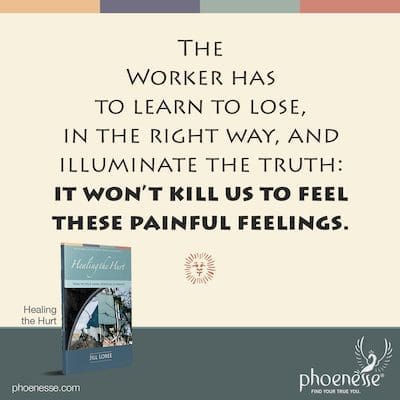
There are three main faults that travel like a band of hooligans: fear, pride and self-will. Pretty much every fault falls under the umbrella of one of these three. They are an inseparable trio, so where we find one, it is always possible to find the other two nearby. It doesn’t matter which one we start with; it only matters that we catch it when the Worker stumbles across one. Then we go scouting for the other two.
Worker: I know I should be nicer to him. But he really makes me angry, the way he acts like I am not important. He will totally ignore me all day and then when he wants something he changes his tune and acts all nice to me. It infuriates me.
Helper: Have you spoken with him about this?
Worker: Absolutely not. He would probably just laugh at me and say I’m making this up.
In this scenario, we can take our pick, because all three faults of fear, pride and self-will are showing up. Fear: the Worker fears being humiliated by this person and is afraid to talk to them about the way their behavior is affecting them. Pride: the Worker is upset that this person makes them feel less-than.
Note, pride shows up in wanting to feel better than the other, which is always a reaction to feeling less than. So we can find pride in feeling less than or better than. Self-will: the Worker digs in their heels and won’t reach out to the other to try to find a way to clear the tension and connect; they choose the action that creates separation.
Let’s take a quick minute to track our way through an example of how childhood wounds can activate each of these three faults. First, there is a painful experience and the child feels rejected, frustrated, disappointed, or something similar. Perhaps the parents got angry over something the child did, and in their angry behavior, they withheld love from the child, or at least so it seemed. So the child fears the pain of being rejected and also fears losing the parent’s love.
Bad, painful feelings cause the child to feel insecure and lacking in self-confidence. Conclusions are drawn along the lines of “I am worthless,” “I don’t matter,” or “I am not lovable.” In some way, the child thinks they are not enough. (Note, images often form around these beliefs.) This feels humiliating, causing pride to show up as compensation for feeling “less than”—I’ll show you that I’m “better than.”
And finally, the child will dig in their heels and apply their self-will to their resistance. They say No. Throughout life, this shows up as not giving, not reaching out, not affording someone the benefit of the doubt when they affect us. We effectively go into a trance, seeing people and situations through the lens of a painful recreation of a childhood hurt. So everyone who comes along and creates a scenario that rubs salt in our old wounds will get a good look at our hand as we put up walls and apply the brakes of our will.
With this Worker, we could start by looking at their fear.
Helper: What are you afraid of? (or What does the fear say?)
Worker: He will make me look like a fool.
Helper: And then what.
Worker: There’s no way he’s going to win. I’m the one who is right.
We can hear how the Worker is digging in the heels of their self-will. And we also hear that the fear is about losing, which to the young inner child equates to the death half of the dualistic life-or-death struggle. Make no mistake, that struggle is alive and well in all of us at the level of this old unfelt pain. We may not consciously realize this, but the young inner aspect who is hurting sure does.
There is also pride embedded in this fear of losing. The fight is that “this time I’m going to win.” That’s a common refrain for the wounded inner child: this time we intend to win. But we’re caught in illusion: it’s not true that we were ever defeated, so it’s not true that we can make the pain go away by winning now. The only way out of this error and struggle is to die into the painful residual feelings.
The Worker has to learn to lose, in the right way, as a way to gain back their dignity and illuminate the truth: it won’t kill us to feel these painful feelings. As we do this work, we will need to die many, many deaths like this, feeling all the built-up painful feelings we weren’t willing or able to feel as children. This is the path that takes us from humiliation to humility.
We can see how the self-will has kicked in as the Worker is talking. There is an inner No that basically says, “I won’t give and I won’t give in.” While the inner child generally speaks from a place of “I can’t”—“this hurts and I can’t take it”—once the Lower Self wraps itself around all of this, there is a negative intention to not budge. The Lower Self will then use the beliefs from hidden images, perhaps something like “I’m not enough and I’ll never be enough,” to keep the mechanism of the faults locked into place.
We aren’t going to move the meter on the self-will by pushing on the Worker using our own will. Even if we see what logical steps the Worker could or should do to defuse a difficult situation, if we start to inject our own advice or forcing current into the session, we are heading in totally the wrong direction. Any offering of suggestions for practical next steps needs to be held out toward the Worker with an open hand for consideration. But if this is done in the middle of the work, it is most apt to cut off the work. The solution doesn’t lie in outside actions—the solution lies in moving through the rocky inner terrain. Once the energy shifts, new approaches for how to handle the “real world” will organically surface inside the Worker.
It is important for the Helper to trust the Worker’s process, letting them follow their own inner guidance from their Higher Self. If they make a mistake, they will learn. If they lean on us, they will not be fulfilling their higher purpose for doing this work, which is to develop that inner connection with their core and to learn to trust it.
In the example given, the discomfort or pain created by the situation being described is far greater than the situation seems to warrant. This is always an important clue that some young aspect trapped inside the Worker’s being is in distress. The pain originated in childhood, and that’s where we need to go to heal it. So the person will regress to feeling the age they were as a child, at the time of the wounding.
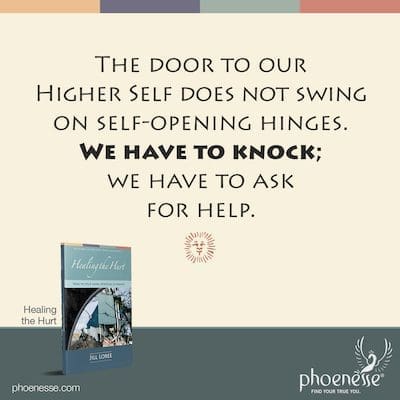
Let’s be clear, for the child, feeling pain is akin to feeling death. We are born into a dualistic plane and we slam into this one every time. But pain does not kill us. It wasn’t going to kill us then, and it’s not going to kill us now. To say that our defenses and faults were what saved us—which many people are fond of expounding—is not true, and it can terrorize this young aspect that is now inching its way forward for healing.
We need to make plenty of space for the Worker to experience their painful feelings, and actively encourage them to go as deeply in and through their feelings as they can. There is no reason to dip our toe into the water of tough emotions and quickly squirt back out. That’s just our habit. Our systems have been well designed to regulate how much we can bear and to navigate us through our feelings like a river guide steering us through whitewater rapids.
During the work of re-experiencing and releasing the pain of a painful childhood recreation, the Worker will have a very hard time distinguishing what happened in the past from what’s happening now. But once pent-up feelings have been expressed, there will be room for new insights to come in, including awareness of old memories that relate to current painful situations.
We will want to coach the Worker to hold the past and the present like two slides, one of what happened then, and one of what’s happening now. The Worker needs to overlay these two, to see how they are the same: the hurt of now is the exact same hurt as the hurt of then. Once the Worker sees how the experiences are the same, they need to come into the present moment by realizing that that was then, and this is now.
This helps the Worker to see two things. First, what’s happening now is only happening because they are magnetically attracting and creating scenarios that scratch open an old wound. And second, the current situation is only as painful as it is because of the old wound. It feels, to the Worker, like they have never left childhood, because this young aspect of them literally has not.
So at the same time that we are inviting the inner child to sit in the room, we need to strengthen and support the adult ego—the one that is holding these two slides in their lap. The adult ego—the one who is witnessing the recreation—is not caught in the recreation. It can hold an objective stance that recognizes “that was then and this is now.” It is often helpful to feed these actual words to the Worker, so they can feel their own inner adult who is now present for holding and comforting the wounded inner child.
Speaking of the adult ego, this aspect of the Worker has a very important job to do: pray. The door to our Higher Self does not swing on self-opening hinges. We have to knock; we have to ask for help. This is the job of the ego, and the Helper cannot do this part for the Worker. We can, however, teach them how to work with all these various selves, and strengthen their connection with each of them.

Next Chapter
Return to Healing the Hurt Contents


